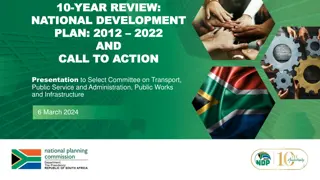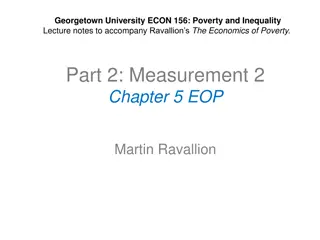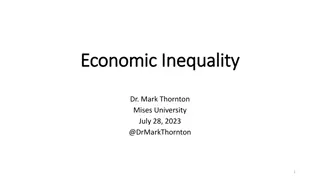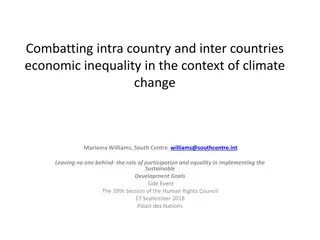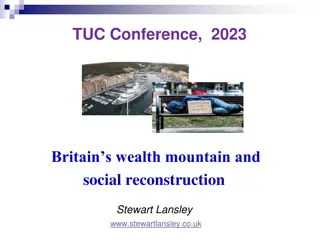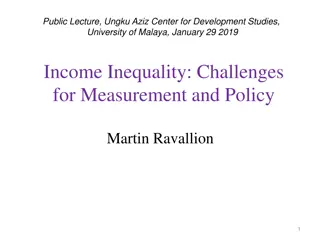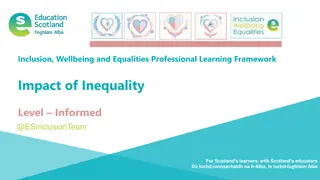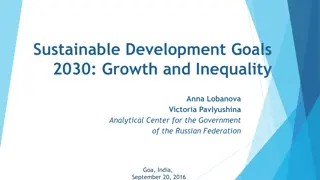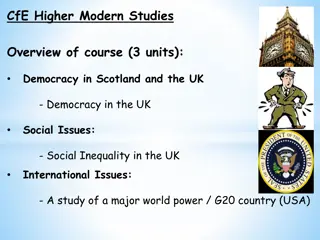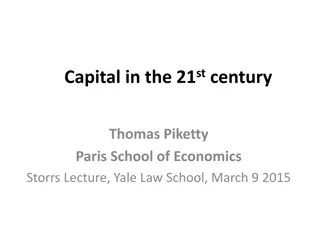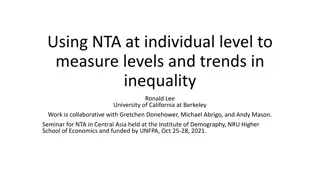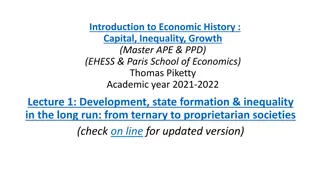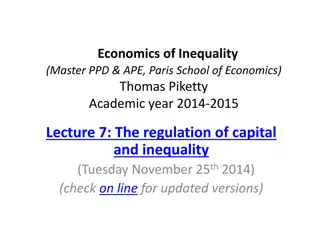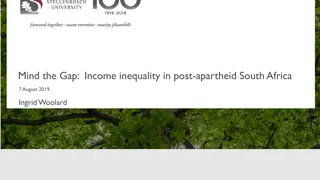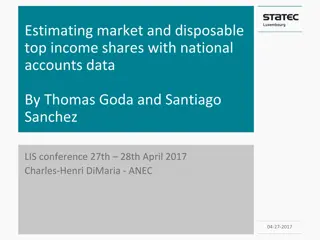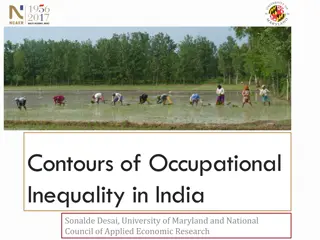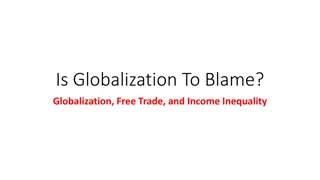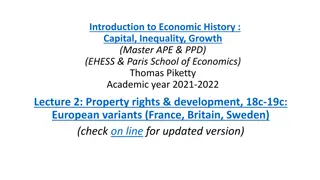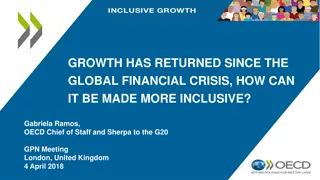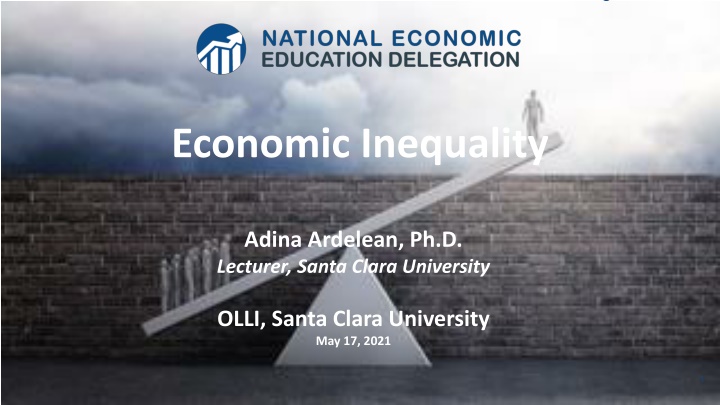
Economic Inequality and National Economic Education
Lecturer Adina Ardelean explores economic inequality, the work of the National Economic Education Delegation, and the impact of income and wealth disparities on policy issues. Discover the causes, measurements, and possible solutions to this pressing societal challenge.
Download Presentation

Please find below an Image/Link to download the presentation.
The content on the website is provided AS IS for your information and personal use only. It may not be sold, licensed, or shared on other websites without obtaining consent from the author. If you encounter any issues during the download, it is possible that the publisher has removed the file from their server.
You are allowed to download the files provided on this website for personal or commercial use, subject to the condition that they are used lawfully. All files are the property of their respective owners.
The content on the website is provided AS IS for your information and personal use only. It may not be sold, licensed, or shared on other websites without obtaining consent from the author.
E N D
Presentation Transcript
Economic Inequality Adina Ardelean, Ph.D. Lecturer, Santa Clara University OLLI, Santa Clara University May 17, 2021 1
National Economic Education Delegation Vision - One day, the public discussion of policy issues will be grounded in an accurate perception of the underlying economic principles and data. Mission - NEED unites the skills and knowledge of a vast network of professional economists to promote understanding of the economics of policy issues in the United States. NEED Presentations - Are nonpartisan and intended to reflect the consensus of the economics profession. 2
Who Are We? Honorary Board: 53 members - 2 Fed Chairs: Janet Yellen, Ben Bernanke - 6 Chairs Council of Economic Advisers o Furman (D), Rosen (R), Bernanke (R), Yellen (D), Tyson (D), Goolsbee (D) - 3 Nobel Prize Winners o Akerlof, Smith, Maskin Delegates: 585+ members - At all levels of academia and some in government service - All have a Ph.D. in economics - Crowdsource slide decks - Give presentations Global Partners: 44 Ph.D. Economists - Aid in slide deck development 3
Credits and Disclaimer This slide deck was authored by: - Jon Haveman, Executive Director of NEED This slide deck was reviewed by: - Timothy Smeeding, University of Wisconsin - Robert Wright, Augustana University Disclaimer - NEED presentations are designed to be nonpartisan - It is, however, inevitable that the presenter will be asked for and will provide their own views - Such views are those of the presenter and not necessarily those of the National Economic Education Delegation (NEED) 5
Outline Definition Measurement How does it happen? Does it matter? Is it a problem? What to do about it 6
Previous Lectures Income inequality is clearly increasing in the U.S. and in other advanced countries. Wealth inequality is higher than income inequality in advanced countries The causes of growing Income Inequality appear to be largely driven by: - The market technology, competition, and trade - Changing institutions. 7
What youll hear today Does inequality matter? How much inequality is too much? Addressing inequality: oRedistribution: Tax and transfer programs oPre-distribution programs 8
Why Does Inequality Matter? Too little inequality can: - Reduce individual motivation - Slow economic growth Too much inequality can: - Reduce individual motivation - Slow economic growth Too much inequality may also: - Divide society - Distort political environment - Reduce political participation - Reduce investments in public goods o Education o Environmental protections
Peru China Brazil Germany U.S. Canada 10 https://equitablegrowth.org/research-paper/are-todays-inequalities-limiting-tomorrows-opportunities
U.S. Racial Differences Odds of staying poor, if born poor Odds of becoming poor, if born rich 12 Economic Policy Institute, State of Working America, 2012
Government Policy and Racial Inequality Product of a long historical process of discrimination with at least two reinforcing sets of policies. - Policies that govern the spatial distribution of the black population. o Restrictive covenants, redlining, and general housing and lending discrimination - Policies that have a disparate impact on black individuals because of their locations. o The original version of Michigan Senate Bill 897 exempted individuals from this work requirement conditional on residing in a county with an unemployment rate above 8.5 percent. The higher unemployment rates in rural counties would disproportionately exempt white Medicaid recipients from the work requirement within the bill. 13
What youll hear today Does inequality matter? How much inequality is too much? Addressing inequality: oRedistribution: Tax and transfer programs oPre-distribution programs 14
How Much Inequality Is too Much? ? ? 100 0 Z Z Z X Gini Coefficient 15
An International Perspective: Trends U.S.: 17-18 Canada, UK, Germany: 12-13 Italy, France, Japan: 7-9 16
An International Perspective: Gini Gini Coefficient, OECD countries, 2019 or latest year available 17 Source: OECD https://data.oecd.org/inequality/income-inequality.htm#indicator-chart
An International Perspective: Poverty rate Poverty Rate by age group, OECD countries, 2019 or latest year available 18 Source: OECD https://data.oecd.org/inequality/poverty-gap.htm#indicator-chart
But the High-Income Households Save More Facilitates the Consumption of: Wealth Which facilitates the consumption of: Leisure 19
What youll hear today Does inequality matter? How much inequality is too much? Addressing inequality: oRedistribution: Tax and transfer programs oPre-distribution programs 20
Addressing Inequality: Is It A Problem? Why it might be a problem. - Economic issues (Efficiency) o There is evidence that at some level, increased inequality slows economic growth. o Or, inequality concentrates resources among investors. - Noneconomic issues (Equity) o Values, ethics and morals will drive individual evaluations of the level of inequality. E.g., inequality is primarily a function of market outcomes, so should be left alone. Or, a solid middle class is important for maintaining a civil society, which runs contrary to a high degree of inequality. Suppose you think it s a problem. How might it be addressed? 21
Addressing Inequality: Immediately Available Policy Solutions (1/2) RE-distribution - Tax and transfer programs PRE-distribution - Access to healthcare and education - Strengthen labor unions - Collective bargaining - Other policies that favor labor over business owners - Minimum wages
Tax and Transfer Potential Policies Government transfers - Full employment policies: unemployment benefits, Trade-Adjustment Assistance - Earned Income Tax Credit (EITC) - Child Tax Credit (CTC) Social safety nets - Expand access to health care - Relax eligibility conditions for SNAP - Housing vouchers, Supplemental Security Income, Social Security Disability Insurance - Universal Basic Income Tax Policies - Reduce payroll tax, introduce wealth tax, keep estate tax, introduce value-added tax
Current Programs and Child Poverty 24 Source: A Roadmap to Reducing Child Poverty, National Academy of Sciences, 2019
Public Spending on Families and Children 25 Source: A Roadmap to Reducing Child Poverty, National Academy of Sciences, 2019
Addressing Inequality: Immediately Available Policy Solutions (1/2) RE-distribution - Tax and transfer programs PRE-distribution - Access to healthcare and education - Strengthen labor unions - Collective bargaining - Other policies that favor labor over business owners - Minimum wages
Early Child Education High-quality birth-five programs for disadvantaged kids can deliver a 13% per year return on investment improving education, employment, health outcomes and savings on later remediation costs. Early education has tremendous benefits for kids. Research shows that kids who experience quality early learning: Are 25% more likely to graduate high school (Perry School Project) Are four times more likely to have completed a bachelor s degree or higher (The Abecedarian Project) Earn up to 25% more in wages as an adult (The Jamaican Study) Government-provided universal preschool education and childcare could financially benefit low- skilled and low-income workers and keep women in the workforce. 29 Source: https://heckmanequation.org/ and Start Early website
Early Education International Perspective 30 Source: OECD Public Spending on childcare and early education
Many States Have A Higher Min Wage NY: $12.50/hour CA: $13/hour States with Higher Minimum Wage than Federal As of Jan 1, 2021 35 Source: U.S. Department of Labor
Minimum Wage International Comparison 38 Source: Statista
Addressing Inequality: Immediately Available Policy Solutions (2/2) Other - Reverse trends in market power Locally - Employment services: job training, interview skills, or assistance with day-to- day issues, such as child care - Cognizance of the potential for technologies to affect worker/employer power dynamics o Uber, Lyft, etc.
Addressing Inequality: Long Term It s all about access to resources: - Education, in particular o Improve public education o Reduce disparities in quality of public education o Improve counseling in low-income schools With respect to college paths to success and funding o Investments are needed in early education, not later (e.g. universal pre-k) - Opportunities for wealth-building - Housing Initiatives whose impacts cross neighborhood and class lines and increase upward mobility specifically for black men - Mentoring programs for black boys, efforts to reduce racial bias among whites, interventions to reduce discrimination in criminal justice, and efforts to facilitate greater interaction across racial groups.
What to do About Inequality? Nothing? Redistribution? PRE-distribution? Access to resources? 41
Tension in Policy Solutions Is it possible to increase growth at the same time that you reduce income inequality? - Common refrain among some that government intervention in the economy is always and everywhere bad for growth. Possibly: expanding equality of access promotes the full utilization of resources. - Expanding equality of access requires resources likely from the well-to-do. 42
Summary Income inequality is clearly increasing. - The economy is clearly favoring owners of productive resources over labor. The causes appear to be largely driven by: - The market technology, competition, and trade - Changing institutions. Open questions are: - To act or not to act? - If so, how? The level of inequality is a policy choice.
Thank you! Any Questions? www.NEEDelegation.org Adina Ardelean <atardelean@scu.edu> Contact NEED: info@needelegation.org Submit a testimonial: www.NEEDelegation.org/testimonials.php Become a Friend of NEED: www.NEEDelegation.org/friend.php 44
Child poverty across U.S. States 45 Source: A Roadmap to Reducing Child Poverty, National Academy of Sciences, 2019

